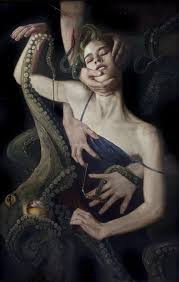Since I have already done some research about the concept "7 Deadly sins" itself, now I am going to do a further research in every sin so that I can deepen my knowledge and consequently better represent it in the project. For this I am going to use the Dante's list in which the first sin is luxuria (lust) and the second one is gula (gluttony).
Luxuria (Lust)
Although lust (or luxuria) is normally associated to an excessive thoughts of sexual nature and desire, it is a lot more than that. It is about apetite, an appetite, a craving, for the forbidden. People become objects for your own pleasure, this can be supported by Dante's criterion - "excessive love of others". Lust prevents the lucidity and purity of understanding. Shameless and sinful thoughts, desire for excitement, or need to be accepted by others are all features that characterize the sin of Lust.
Symbols
Althought fruit might be considered as one of the most unassuming object, it became an important tool for artists to suggest an idea, an message through their colours, textures and the associated scents. There are numerous interpretations but the apple, pomegranate, fig, grapes and peach are 5 fruits that can be associated with this sin.
The cow and snake and cow also symbolize this sin, as well as the color bue, possibly because of the sadness that follows sin, given that lust might destroy relationships and lead those who sin to become lonely. The punishment is fire and brimstone.
Gula (gluttony)
Gula also known as gluttony (derived from the latin gluttire "to gulp down or swallow") means excessive consumption of food, drinks, or wealth items. Gluttony is considered a sort of gateway sin by Evagrius - "When the intellect is blunted by satiety,it does not receive the knowledge of God." Gluttony is the rejection to share, the waste after consuming. Anything that you consume that exceeds what you really need can be considered gluttony.
Symbols
This sin may be represented by the pig since when we think about an animal that overeats this is the one that come to our minds. Furthermore, it can also be represented by the color orange, which I believe it is well represented in the painting os Jacques de L'Ange, because it is believed that orange stimulates the appetite. Those who practice gluttony are punished by eating rats, snakes and toads, which is something to consider for the outcome of this painting.
Reference:
Writer S. (2020), What Are the Symbols of the Seven Deadly Sins? [online], Reference, Available from:



Again all of this is copied and pasted from other sources - you must write in your own words and use research as research! Please start doing this.
ReplyDelete